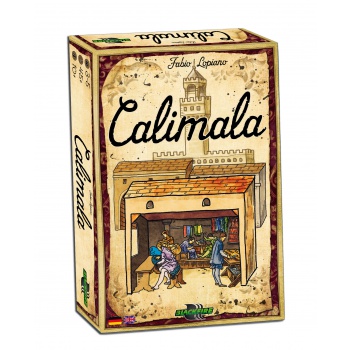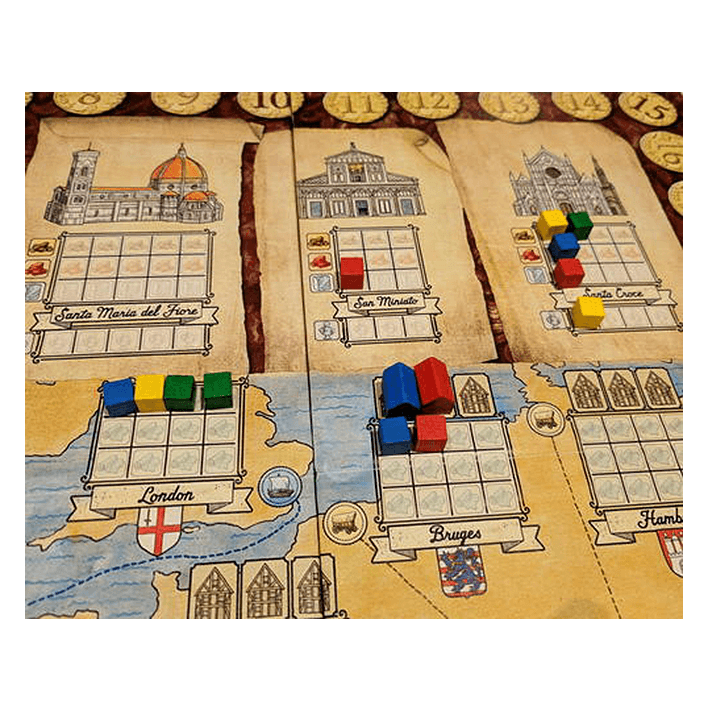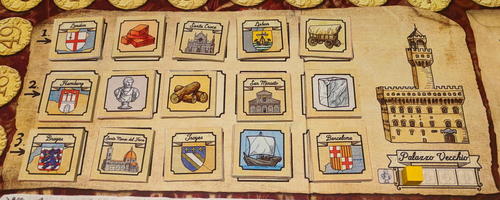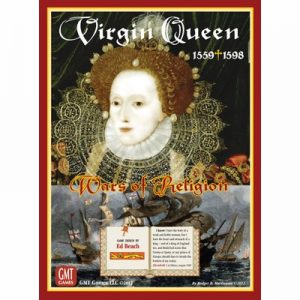Beschrijving
Min leeftijd: +10
Aantal spelers 3 a 5
Gem speelduur 75 min
De “Arte di Calimala” – het gilde van lakenverwerkers en handelaren in buitenlandse stoffen – was een van de grotere gilden van Florence, die zich tijdens de late middeleeuwen de burgermacht van de Republiek Florence aanmatigden. De handel in wollen stoffen was de motor die de economie van de stad aandreef en de leden van de Calimala vormden de elite van Florence.
Gedurende zijn lange geschiedenis hield de Arte di Calimala toezicht op de uitvoering van artistieke en architectonische werken. De meeste Florentijnse gilden voerden dergelijke activiteiten uit, maar de Calimala onderscheidde zich van andere gilden door het aantal en het prestige van de projecten en de beheerde locaties, inclusief de bouw en decoratie van enkele van de belangrijkste kerken van de stad.
Spelers van Calimala zijn stoffenhandelaren in het middeleeuwse Florence, met een aantal vertrouwde medewerkers die ze aan verschillende straten in de stad toewijzen om acties uit te voeren. (Elke straat verbindt twee plaatsen waar specifieke acties kunnen worden ondernomen.) Terwijl ze deze acties uitvoeren, produceren en leveren spelers stoffen en dragen ze bij aan de constructie en decoratie van verschillende gebouwen in de stad. Medewerkers blijven een tijdje op hun toegewezen plaats en voeren hun acties uit wanneer de straat wordt geactiveerd, en worden uiteindelijk gepromoveerd tot de gemeenteraad, wat een scorefase in gang zet.
Afhankelijk van het aantal spelers beschikt iedere speler over een aantal actieschijven. In beurtvolgorde kunnen ze er één op een veld tussen twee acties plaatsen, waarbij ze beide acties uitvoeren en alle andere schijven op hetzelfde veld activeren. Wanneer de vierde schijf op een actieveld wordt geplaatst, wordt de laagste gepromoveerd tot gemeenteraad, wat een puntentelling activeert. Nadat de laatste actieschijf is geplaatst of de laatste scorefase in de raad is geactiveerd, eindigt het spel. De posities van de actievelden en de volgorde van de scorefasen variëren van spel tot spel, waardoor elk spel heel anders is. Geheime scoredoelen en actiekaarten zorgen voor onzekerheid.
The “Arte di Calimala” — the guild of cloth finishers and merchants in foreign cloth — was one of the greater guilds of Florence, who arrogated to themselves the civic power of the Republic of Florence during the Late Middle Ages. The woolen cloth trade was the engine that drove the city’s economy and the members of the Calimala were the elite of Florence.
Throughout its long history, the Arte di Calimala supervised the execution of artistic and architectural works. Most Florentine guilds performed such activities, but the Calimala distinguished itself from other guilds through the number and prestige of the projects and the sites administered, including the construction and decoration of some of the major churches of the city.
Players of Calimala are cloth merchants in medieval Florence, with a number of trusted employees that they assign to various streets within the city to carry out actions. (Each street connects two places where particular actions can be taken.) While taking these actions, players produce and deliver cloth and contribute to the construction and decoration of various buildings across the city. Employees stay on their assigned places for a while, carrying out their actions whenever the street is activated, and eventually are promoted into the city council, triggering a scoring phase.
Depending on the number of players, each player has a number of action discs. In turn order, they can put one on a space between two actions, performing both actions and activating all other discs on the same space. When the fourth disc is placed on an action space, the lowest one is promoted to the city council, which triggers a scoring. After the last action disc is placed or the last scoring phase in the council is triggered, the game ends. The positions of the action spaces and sequence of scoring phases vary from game to game, making each game very different. Secret scoring objectives and action cards add uncertainty.







